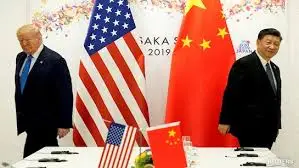US and China agree to slash reciprocal tariffs in de-escalation of trade war

US and China Agree to Slash Reciprocal Tariffs: A Major Step Toward Trade De-escalation
In a significant breakthrough, the United States and China have reached an agreement to dramatically reduce the tariffs that have defined their trade conflict for years. This development marks a pivotal moment in the ongoing trade war between the two global superpowers, which has led to economic uncertainty and strained international markets.
A Strategic De-escalation
Following intense negotiations in Geneva, U.S. Treasury Secretary Scott Bessent and Chinese Vice Premier He Lifeng jointly announced a 90-day moratorium on new tariffs. Additionally, the two nations agreed to slash existing reciprocal tariffs by an impressive 115 percentage points, signaling a potential thaw in relations.
Under the new terms, U.S. tariffs on Chinese imports will decrease from 145% to a more manageable 30%. In response, China will lower tariffs on U.S. goods from 125% to 10%. This agreement aims to reduce the financial strain on both countries’ economies, particularly the U.S. consumer market, which has felt the sting of increased import prices due to the high tariffs.
Economic Pressures Leading to the Deal
The decision to reduce tariffs comes as both nations face mounting economic challenges. In the United States, businesses and consumers have experienced product shortages and increased prices for everyday goods, particularly in sectors like electronics and retail. For American farmers and retailers who rely on the Chinese market, the tariff dispute has added a layer of complexity to their operations.
On the other side, China has felt the weight of retaliatory measures, impacting its export economy and increasing tensions within the region. By coming together to sign this temporary agreement, both parties are acknowledging the necessity to avoid further escalation and to prioritize economic stability.
A Temporary Agreement with Long-Term Potential
While the current deal only covers a 90-day period, there is cautious optimism that this pause could lead to a more sustainable solution. Both U.S. and Chinese officials have expressed the hope that this agreement could help reduce the massive trade deficit the U.S. has with China, which currently stands at around $1.2 trillion.
The Biden administration has consistently emphasized the importance of balancing trade between the two countries while avoiding a full economic decoupling. The deal represents a shift toward diplomacy over confrontation, with both sides eager to protect their economic interests without pushing the global economy into a recession.
The Market’s Positive Reaction
Global financial markets have responded positively to the announcement. The U.S. stock market saw an immediate spike, with the S&P 500 futures climbing by 2.8%, signaling investor confidence in the agreement’s potential impact. Additionally, the U.S. dollar strengthened by 0.7%, while gold prices fell 2.3%, reflecting the market’s perception of reduced economic risk in the short term.
Analysts believe this reduction in trade tensions could provide a significant boost to global trade and markets. However, while the agreement represents progress, some experts caution that the long-term effects remain to be seen, with potential for future renegotiations and adjustments.
Conclusion: A Glimmer of Hope for Global Trade
This tariff reduction deal between the U.S. and China offers a glimmer of hope for the future of international trade relations. Both countries have made a conscious decision to step back from the brink of further economic confrontation, choosing cooperation over escalation.
As the next 90 days unfold, the world will be watching closely to see if this agreement can lay the groundwork for a more enduring peace in trade relations or if the tensions will flare up once again.






